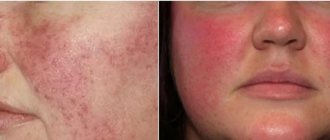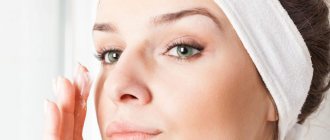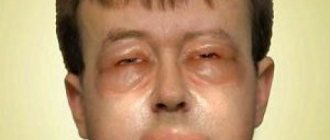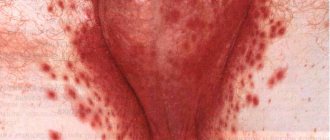Blepharitis is an inflammation of the ciliary margin of the eyelids, which is usually chronic and bilateral. Blepharitis takes a long time and is difficult to treat. Although in most cases the development of blepharitis is caused by infection, the state of immunity plays an important role. The occurrence of blepharitis is possible only with a weakened immune system, so blepharitis is always a reason to pay attention to the state of the immune system. Blepharitis often develops in older people; this is associated with age-related atrophy of the epithelium and, as a consequence, a decrease in local immunity.
Causes of blepharitis
Blepharitis can develop as a complication of chronic eye diseases - keratitis, conjunctivitis. Meibomian blepharitis is caused by dysfunction of the meibomian glands (these glands, located along the edge of the eyelids, produce a secretion that prevents the evaporation of tear fluid and thereby helps moisturize the eye). Blepharitis can be of an allergic nature (quite typical for hay fever - an allergy to pollen, and can be observed as a reaction to the cosmetics used).
Separately, it is worth highlighting demodicosis - damage to eyelashes by mites of the genus Demodex. These mites live in the sebaceous glands and hair follicles on the face of most people. When the immune system is weakened, demodex mites become more active. One of the varieties of demodex mites prefers eyelashes for its habitat, therefore, with demodicosis, the development of blepharitis is very likely.
The occurrence of blepharitis is also possible due to the action of general factors - vitamin deficiency, helminthic infestations, metabolic disorders (in particular, diabetes), pathologies of the gastrointestinal tract, anemia. Against the background of such diseases, the likelihood of infection of the eyelids increases significantly. The infection can enter this area from another source of inflammation through the hematogenous route (that is, through the bloodstream). In this case, blepharitis can develop as a complication of sinusitis, chronic tonsillitis, caries.
Factors contributing to the development of blepharitis also include uncorrected visual impairment. If a person with nearsightedness, farsightedness or astigmatism does not correct vision with glasses or optical lenses, he is forced to peer intensely, straining the eye muscles. The muscles get tired, and the person begins to rub his eyes, thus causing an infection. The tension of the eye muscles itself, although it cannot directly cause inflammation, favors its preservation and development.
For what reasons does atopic dermatitis occur on the eyelids?
Numerous studies have found that the main cause of atopic dermatitis is heredity. If at least one of the parents has the disease, then with a probability of up to 50% it can appear in the child. However, to start the pathological process, a certain triggering factor is required that provokes inflammation of the skin. They are individual for each patient.
One of the common causes of atopic dermatitis on the eyelids is considered to be an excessive reaction to various irritants. These may be chemical components in cleansers or detergents, food products, cosmetics or skin care products, some medications, dust contained in the air, pollen, insect secretions, and the like.
Atopic dermatitis around the eyes is more common in children.
Only a doctor can diagnose the disease and identify the cause of exacerbations. Therefore, when the first signs of atopic dermatitis of the eyelids appear, you should consult a specialist.
Contrary to the fears of parents, atopic dermatitis does not occur in the eyes; the rashes are located near the eyes on the thin sensitive skin of the eyelids. But with severe inflammation, redness of the eyes and watery eyes may occur.
The photo below shows how atopic dermatitis occurs on the eyelids.
Photo 1. Atopic dermatitis on the eyelids.
- When atopic dermatitis affects the eyelids and the area around the eyes, redness of the skin, tissue swelling, severe itching may appear, sometimes the sclera may even become red and swollen, and the blood vessels in the eye may dilate. In some cases, atopic dermatitis of the eyelids is not accompanied by such a pronounced reaction; only peeling and roughening or thickening of the skin is noted.
To choose the right treatment for atopic dermatitis in the skin around the eyes, you need to be able to correctly diagnose this disease. Often, other types of skin diseases are “masked” under atopic dermatitis under the eyes and in the periorbital area:
- Seborrheic dermatitis. Characteristic signs of this pathology are peeling of the skin, the appearance of yellow crusts in the eyelashes and eyebrows, itching, and loss of eyelashes.
- Drug dermatitis. It occurs as a result of taking certain medications (not only after using certain eye drops, but taking drugs orally) and physiotherapeutic treatment (for example, electrophoresis).
- Eczematous dermatitis. It is not so common, the rashes have their own characteristics, usually itching. In addition to inflammation, rash, itching and flaking of the skin, patients may additionally complain of eye pain.
- Herpetic dermatitis. Viral herpes can be localized not only on the lips, genitals, but also on the eyelids. It can be distinguished from other forms of the disease by the presence of small bubbles with watery contents. Herpetic dermatitis is one of the most dangerous lesions in the eye area; ulcers can spread to the eye area and lead to deterioration or loss of vision. The disease often occurs with fever and headaches.
- Contact dermatitis. It is allergic in nature and occurs due to direct contact with an irritant. Most often these are decorative or caring cosmetics.
Types of blepharitis
Simple blepharitis
If the edge of the eyelid just turns red, they talk about simple blepharitis
.
Squamous blepharitis
With scaly blepharitis, dry grayish-yellow scales, reminiscent of dandruff, form at the roots of the eyelashes. If the scales are removed, thin, reddened skin can be found underneath.
Ulcerative blepharitis
Ulcerative blepharitis usually develops as a result of staphylococcal infection. With ulcerative blepharitis, pus accumulates in the hair follicles of the eyelashes. Eyelashes stick together. At the base of each such tuft of eyelashes there is a yellow purulent crust, and if it is removed (the eyelashes usually fall out), an ulcer opens in its place. In place of healed ulcers, scar tissue forms, which can prevent normal eyelash growth. In severe cases, the entire eyelid margin may be distorted. Madarosis is also possible
– complete loss of eyelashes.
Meibomian blepharitis
In meibomian blepharitis, the meibomian glands become inflamed. Inflammation is caused by increased production of secretions that accumulate at the mouth of the gland. There is a blockage of the mouth, which manifests itself as the appearance of transparent bubbles along the edge of the eyelid.
Masks against wrinkles around the eyes
Homemade masks against wrinkles around the eyes have a lot of useful properties :
- prevent dryness;
- have a rejuvenating effect;
- help accelerate cell turnover;
- raise tone;
- saturate with all microelements;
- protect the skin from harmful external influences.
You should start using masks at the age of 25-27 years, before the first wrinkles appear , in order to prevent their formation.
Important! Masks should consist exclusively of natural ingredients so as not to have a traumatic effect or irritation.
Such homemade products have a complex effect.
Methods for diagnosing blepharitis
To determine the causes of blepharitis, a scraping is taken from the affected area for further laboratory analysis.
Demodex analysis
If demodicosis is suspected, a microscopic examination is performed - demodex analysis.
More information about the diagnostic method
Allergy tests
If blepharitis is allergic, allergy tests may be required.
More information about the diagnostic method
Sign up for diagnostics To accurately diagnose the disease, make an appointment with specialists from the Family Doctor network.
Prevention
Once you have gotten rid of the redness, it is recommended to follow some rules to prevent the symptoms from reoccurring. This:
- proper rest (a person should sleep at least 8 hours a day + - 1 hour);
- proper nutrition will increase the body's defenses and prevent the occurrence of vitamin deficiency;
- sufficient physical activity is the key to success, beauty and health (exercise at least 3–5 hours a week, this time can be distributed at your discretion);
- take care of your eyes using nourishing masks and creams;
- quit smoking and drinking alcohol.
If spots are the cause of the disease, take preventive courses in a timely manner and be observed by the appropriate doctor.
Blepharitis Treatment Methods
Treatment of blepharitis requires an integrated approach, involving both local and general therapeutic measures.
The cause that caused the blepharitis must be eliminated, otherwise local treatment risks not being effective and resumption of inflammation is very likely. The complex of general treatment measures includes:
- vitamin therapy;
- therapeutic nutrition with a high protein content and the exclusion of possible allergens;
- general strengthening and immunostimulating techniques;
- elimination of foci of infection existing in the body (treatment of concomitant diseases.
It is necessary to ensure proper eye hygiene. If necessary, vision correction should be performed to relieve tension in the eye muscles.
Specialist consultation
Local drug treatment is prescribed by a doctor; the specifics of treatment depend on the form (type) of the disease.
For treatment of blepharitis, you should consult an ophthalmologist.
Make an appointment Do not self-medicate. Contact our specialists who will correctly diagnose and prescribe treatment.
Rate how useful the material was
thank you for rating
Blepharitis - symptoms and treatment
Drug therapy is used to treat blepharitis
Drug therapy
Drug therapy includes local and systemic antibiotics, topical glucocorticosteroids and tear replacement therapy.
Local antibiotics
This treatment method is relevant for anterior blepharitis. In this case, patients can use ointment forms or eye drop forms. Unfortunately, some patients require chronic therapy.[9]
Systemic antibiotics (orally)
There is evidence that drugs from the group of tetracyclines and macrolides are effective against meibomian gland dysfunction. Their action is not based on direct combat against microorganisms, but on relieving inflammation and the ability to regulate lipid metabolism.[10]
Local glucocorticosteroids
Short courses of local steroid therapy are indicated to relieve symptoms, and in combination with specific antibiotics (for example, the tobramycin/dexamethasone combination) is especially advantageous due to the lipid-stabilizing properties of the first drug in the combination. There are isolated retrospective studies proving the effectiveness of 0.05% cyclosporine, but these facts require more complete study.
Tear replacement therapy
This method of treating blepharitis is very common, since most patients with blepharitis have problems associated with rapid rupture of the tear film, which can be unpleasant both due to the dry eye syndrome itself and the intensification of blepharitis itself due to excessive friction of the eyelid on the insufficiently moistened surface of the conjunctiva.
Use of Omega-3 polyunsaturated fatty acids
According to the recommendation of The international workshop on meibomian gland dysfunction, their use can reduce the frequency and severity of meibomian gland dysfunction.
LipiFlow
This patented system provides a pulsating and warming effect on the eyelids, distributed throughout the United States. The procedure lasts 5 minutes, the entire course lasts at least two weeks. Its effectiveness has been proven[11], but for patients living in Russia, I would recommend a procedure that is a little more complex than LipiFlow, but more affordable. More details about this method can be found below in the “Forecast” section. Prevention".
Intraductal probing of the meibomian gland
This medical procedure, which is extremely rare in Russia, is highly effective due to the elimination of the root cause.[12] A probe penetrates the meibomian gland through which the drug is administered.
Other treatments and physical therapy for treating blepharitis
Influences that boil down to heating and squeezing out the meibum will be effective. However, physical therapy, in addition to its main effects, has secondary effects that have not been sufficiently studied. Darsonvalization and magnetotherapy are unproven methods; they are used only in the CIS countries.
Diet for blepharitis
Some researchers claim that following a diet rich in Omega-3 polyunsaturated fatty acids has a beneficial effect on posterior blepharitis.
Also recommended products:
- linseed oil;
- fatty fish - salmon, mackerel, herring, sardines and tuna;
- whole grains;
- vegetable protein, beans;
- fresh fruits and green vegetables.
You should drink more water, avoid foods with trans fats and saturated fats, and limit your alcohol consumption [14].
Recommendations for the treatment of blepharitis
During treatment for blepharitis, you should not apply cosmetics to the edge of the eyelid; you should use mascara with caution, tinting only the edge of the eyelashes. It is not recommended to use eyeliners and shadows. Wearing contact lenses is not contraindicated unless the patient has blepharoconjunctivitis or blepharitis is associated with a bacterial infection. However, it is important to carefully monitor the cleanliness of soft contact lenses, as they can become excessively contaminated with meibum.
Treatment of blepharitis in children
In children, blepharitis is often associated with gastrointestinal dysfunction. There is no reliable data on the direct connection, as well as on the pathophysiology of the process, but many experts note such a connection. Most often, blepharitis is accompanied by constipation.
Prevention and treatment of blepharitis in children is complicated by the inability to adequately and regularly perform eyelid hygiene, compresses and massage.
How to treat blepharitis at home
In the chronic form of posterior blepharitis, you can independently make compresses with massage, described below. For other types of blepharitis, especially in the acute stage, it is undesirable to self-medicate, due to the patient’s inability to make a correct diagnosis for himself. Diagnosis requires biomicroscopy (slit lamp examination) and some other tests.










